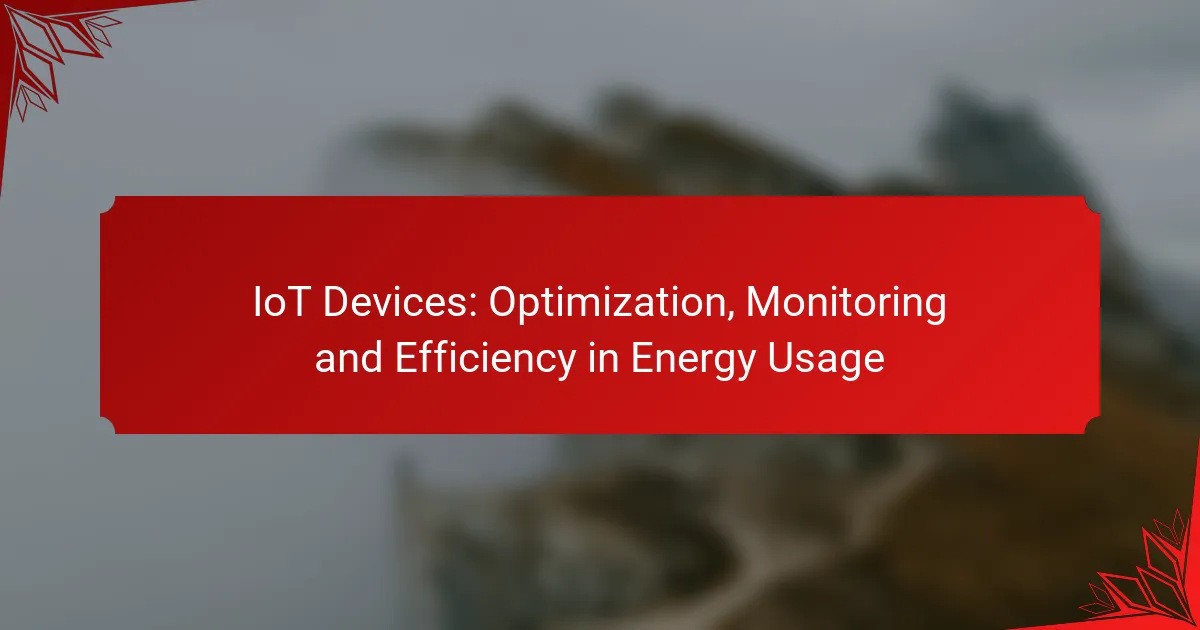Energy storage solutions play a crucial role in enhancing the reliability and efficiency of power systems, offering various technologies such as lithium-ion batteries, flow batteries, and pumped hydro storage. Each solution presents unique advantages in terms of capacity, reliability, and cost-effectiveness, catering to diverse energy needs. By understanding these factors, consumers can make informed choices that optimize their energy management and ensure consistent power supply.
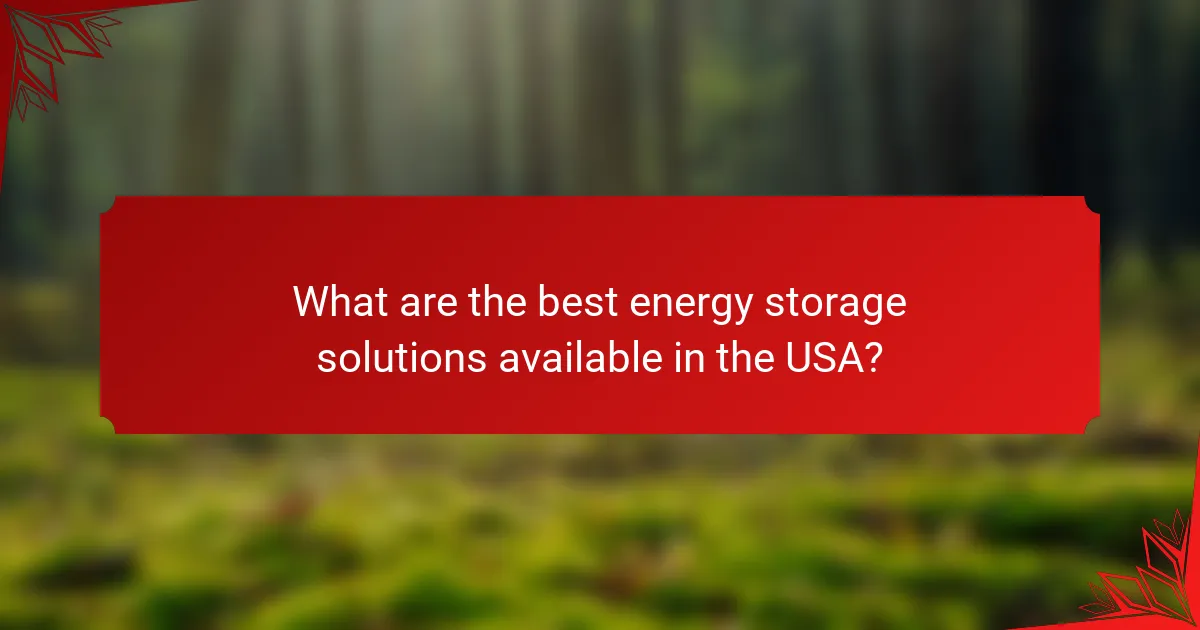
What are the best energy storage solutions available in the USA?
The best energy storage solutions in the USA include lithium-ion batteries, flow batteries, compressed air energy storage, pumped hydro storage, and thermal energy storage. Each option varies in capacity, reliability, and cost-effectiveness, making them suitable for different applications and needs.
Lithium-ion batteries
Lithium-ion batteries are widely used for energy storage due to their high energy density and efficiency. They are commonly found in consumer electronics and electric vehicles, but they are increasingly being deployed in residential and commercial energy systems.
These batteries typically offer quick response times and can last for several years with proper management. However, they can be expensive, with costs ranging from $200 to $600 per kWh, depending on the scale and application.
Flow batteries
Flow batteries utilize two electrolyte solutions that flow through a cell to generate electricity, allowing for scalable energy storage. They are particularly suited for large-scale applications, such as renewable energy integration, due to their long cycle life and ability to discharge over extended periods.
While flow batteries can have higher upfront costs compared to lithium-ion systems, their longevity and lower degradation rates can make them more cost-effective over time, especially for large installations.
Compressed air energy storage
Compressed air energy storage (CAES) involves storing energy by compressing air in underground caverns or tanks. When energy is needed, the compressed air is released, heated, and expanded to drive turbines and generate electricity.
This method is particularly effective for large-scale energy storage and can provide significant capacity, often exceeding hundreds of megawatt-hours. However, CAES systems require specific geological formations and can have high initial costs, making them less common than other solutions.
Pumped hydro storage
Pumped hydro storage is the most established form of large-scale energy storage, utilizing two water reservoirs at different elevations. During periods of low energy demand, excess electricity is used to pump water to the higher reservoir. When demand rises, the stored water is released to generate electricity through turbines.
This method is highly efficient, with round-trip efficiencies often exceeding 70%. However, it requires suitable geographical locations and significant infrastructure investment, which can limit its deployment in some areas.
Thermal energy storage
Thermal energy storage systems store energy in the form of heat, which can be used later to generate electricity or provide heating. Common methods include molten salt storage and ice storage, where heat or cold is produced during off-peak hours and utilized during peak demand.
This solution is particularly useful for integrating renewable energy sources like solar and can enhance grid stability. The costs can vary widely based on the technology and scale, but thermal storage often provides a lower-cost alternative for large-scale applications compared to battery systems.
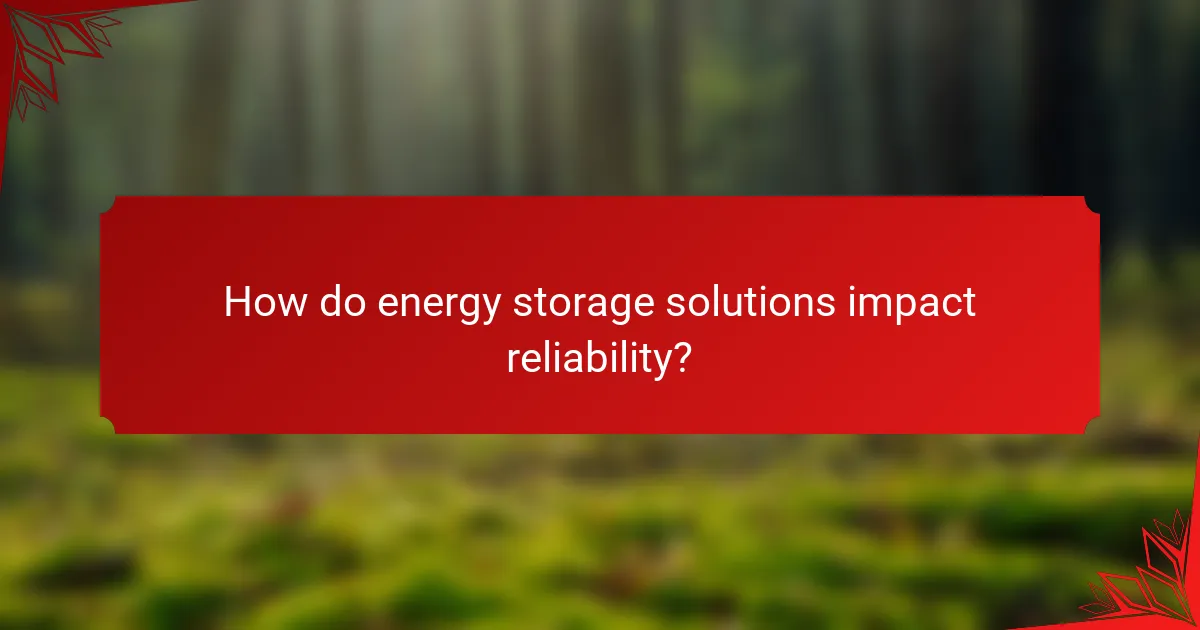
How do energy storage solutions impact reliability?
Energy storage solutions enhance reliability by providing backup power during outages and balancing supply and demand. They help maintain a stable energy supply, reducing the risk of blackouts and ensuring consistent service for consumers.
Increased grid stability
Energy storage systems contribute to increased grid stability by smoothing out fluctuations in energy supply and demand. They can quickly release stored energy during peak demand periods, preventing overloads and maintaining voltage levels within acceptable ranges.
For instance, in regions with high renewable energy penetration, such as wind and solar, energy storage can absorb excess generation during low demand and release it when needed, thus stabilizing the grid. This capability is essential for modern grids that rely on variable energy sources.
Peak load management
Peak load management is a critical function of energy storage solutions, allowing utilities to manage high demand periods effectively. By discharging stored energy during peak times, these systems can reduce the need for additional generation capacity, which is often more expensive and less environmentally friendly.
Utilities can implement demand response programs that incentivize consumers to reduce usage during peak hours, complemented by energy storage systems that provide immediate power. This combination can lead to significant cost savings and improved reliability for the grid.
Integration with renewable energy
Integrating energy storage with renewable energy sources enhances reliability by addressing the intermittent nature of these resources. Storage systems can capture excess energy generated during sunny or windy periods and supply it when generation is low, ensuring a continuous energy flow.
For example, a solar farm paired with battery storage can provide power even after sunset, making renewable energy a more reliable option. This integration not only supports grid reliability but also helps in meeting regulatory targets for renewable energy usage.

What are the cost-effectiveness factors of energy storage?
The cost-effectiveness of energy storage solutions hinges on several key factors, including initial investment costs, ongoing operational expenses, and the timelines for return on investment. Understanding these elements helps businesses and homeowners make informed decisions about energy storage options.
Initial investment costs
Initial investment costs refer to the upfront expenses required to purchase and install energy storage systems. These costs can vary significantly based on the technology used, such as lithium-ion batteries or flow batteries, and the scale of the installation. For residential systems, initial costs typically range from a few thousand to tens of thousands of USD.
When evaluating initial costs, consider potential incentives or rebates available in your area, which can substantially reduce the financial burden. Additionally, assess the system’s capacity and expected lifespan to ensure a balanced investment.
Operational and maintenance costs
Operational and maintenance costs encompass the ongoing expenses associated with running and maintaining energy storage systems. These costs can include electricity for charging, routine inspections, and repairs. Generally, operational costs are lower for newer technologies, with many systems requiring minimal maintenance.
It’s crucial to factor in these ongoing costs when calculating the overall cost-effectiveness of a storage solution. For instance, some systems may have higher initial costs but lower operational expenses, leading to better long-term savings.
Return on investment timelines
Return on investment (ROI) timelines indicate how long it will take for the savings generated by an energy storage system to equal the initial and ongoing costs. Depending on factors like energy prices and usage patterns, ROI timelines can range from a few years to over a decade.
To optimize ROI, consider strategies such as peak shaving, which reduces energy costs during high-demand periods, or utilizing stored energy during outages. Evaluating local energy rates and potential savings can help you estimate a more accurate ROI timeline for your specific situation.
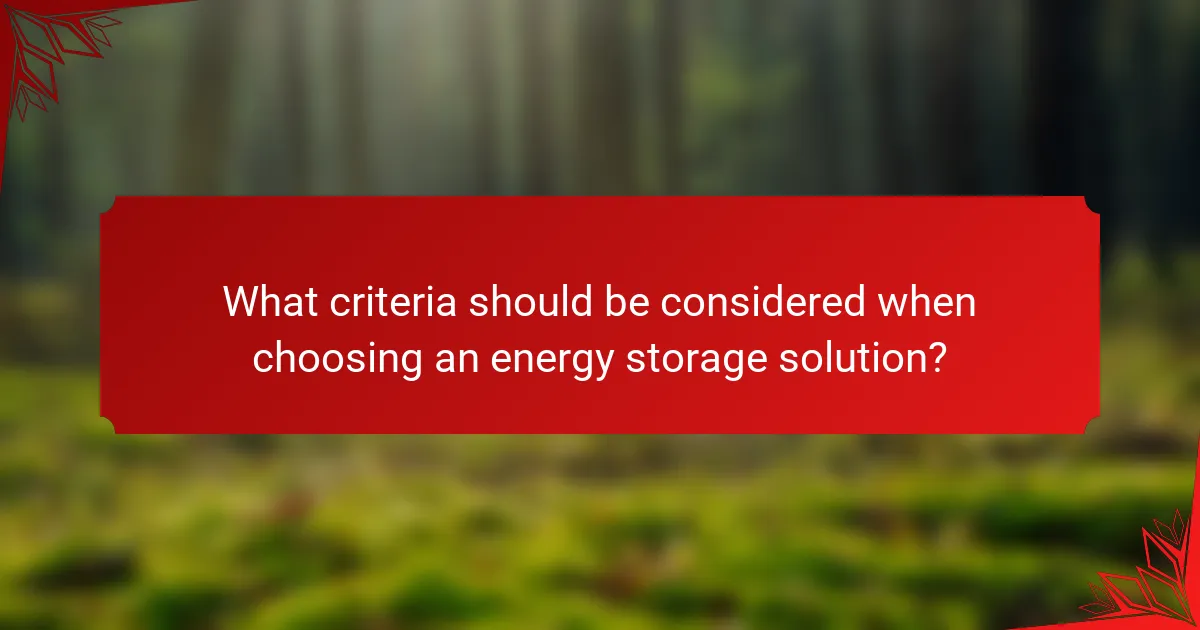
What criteria should be considered when choosing an energy storage solution?
When selecting an energy storage solution, key criteria include capacity requirements, location and space availability, and potential regulatory incentives. These factors will help determine the most suitable and cost-effective system for specific energy needs.
Capacity requirements
Capacity requirements refer to the amount of energy that needs to be stored and delivered based on usage patterns. Assessing peak demand and average consumption is crucial; for instance, residential systems may require storage ranging from a few kilowatt-hours (kWh) to tens of kWh, while commercial setups might need hundreds of kWh.
Consider how long the stored energy needs to last during outages or peak usage times. Systems designed for short-duration support may prioritize rapid discharge, while those for longer durations might focus on total energy capacity.
Location and space availability
Location and space availability significantly influence the choice of energy storage systems. For instance, urban areas may have limited space, necessitating compact solutions like lithium-ion batteries, while rural settings might accommodate larger installations like pumped hydro storage.
Evaluate the physical footprint of the storage solution, including installation requirements and accessibility for maintenance. Additionally, consider local climate conditions, as temperature extremes can affect the performance and lifespan of certain technologies.
Regulatory incentives
Regulatory incentives can enhance the financial viability of energy storage solutions. Many regions offer tax credits, rebates, or grants for the installation of energy storage systems, which can significantly reduce upfront costs.
Research local regulations and utility programs to identify available incentives. For example, in the European Union, various member states provide support for renewable energy integration, which often includes storage solutions. Understanding these incentives can help in making informed decisions and maximizing return on investment.
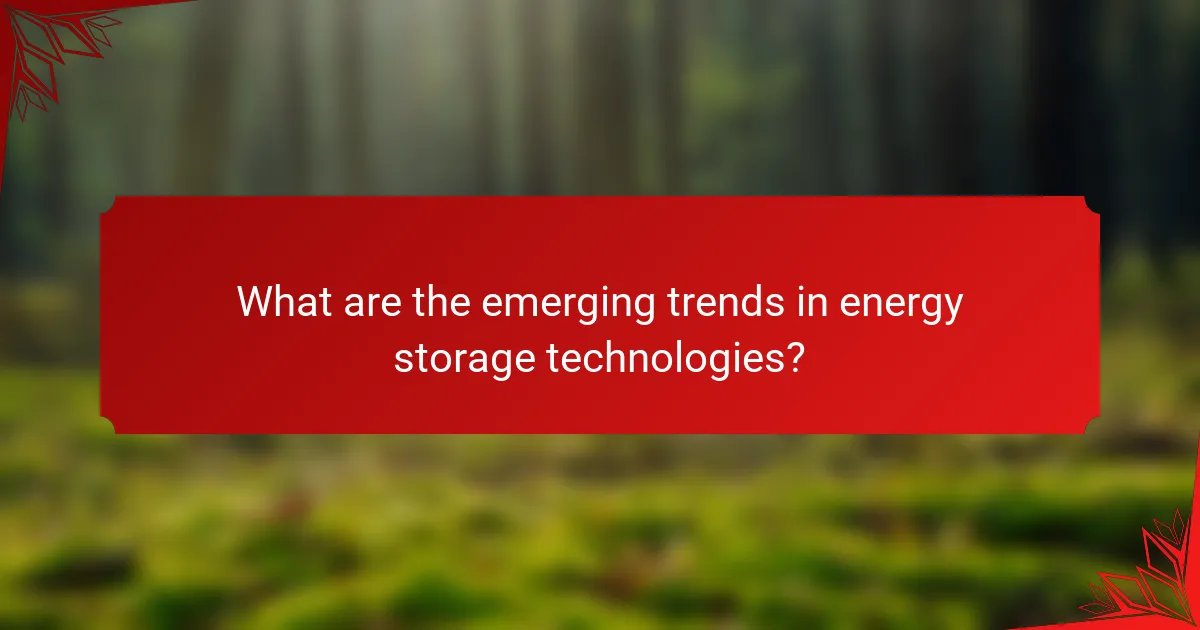
What are the emerging trends in energy storage technologies?
Emerging trends in energy storage technologies focus on enhancing capacity, reliability, and cost-effectiveness. Key developments include advancements in solid-state batteries, integration with smart grids, and increased use of artificial intelligence to optimize energy management.
Advancements in solid-state batteries
Solid-state batteries represent a significant leap in energy storage technology, utilizing solid electrolytes instead of liquid ones. This shift enhances safety by reducing flammability risks and increases energy density, allowing for longer-lasting power in smaller packages.
Manufacturers are exploring various materials, such as sulfide and oxide electrolytes, to improve performance. These advancements could lead to batteries that charge faster and last longer, making them suitable for electric vehicles and renewable energy applications.
Integration with smart grids
Smart grids enhance the efficiency of energy distribution by incorporating advanced communication and automation technologies. Energy storage systems integrated with smart grids can respond in real-time to fluctuations in supply and demand, optimizing energy use and reducing costs.
For instance, during peak demand, stored energy can be released to balance the load, while excess renewable energy can be stored for later use. This integration not only improves reliability but also supports the transition to more sustainable energy sources.
Increased use of artificial intelligence
Artificial intelligence (AI) is increasingly being employed to manage energy storage systems more effectively. AI algorithms can analyze data from various sources to predict energy demand, optimize charging and discharging cycles, and enhance overall system efficiency.
By leveraging machine learning, energy storage operators can make informed decisions that minimize costs and maximize performance. For example, AI can determine the optimal times to store energy when prices are low and release it when demand and prices are high, leading to significant savings.
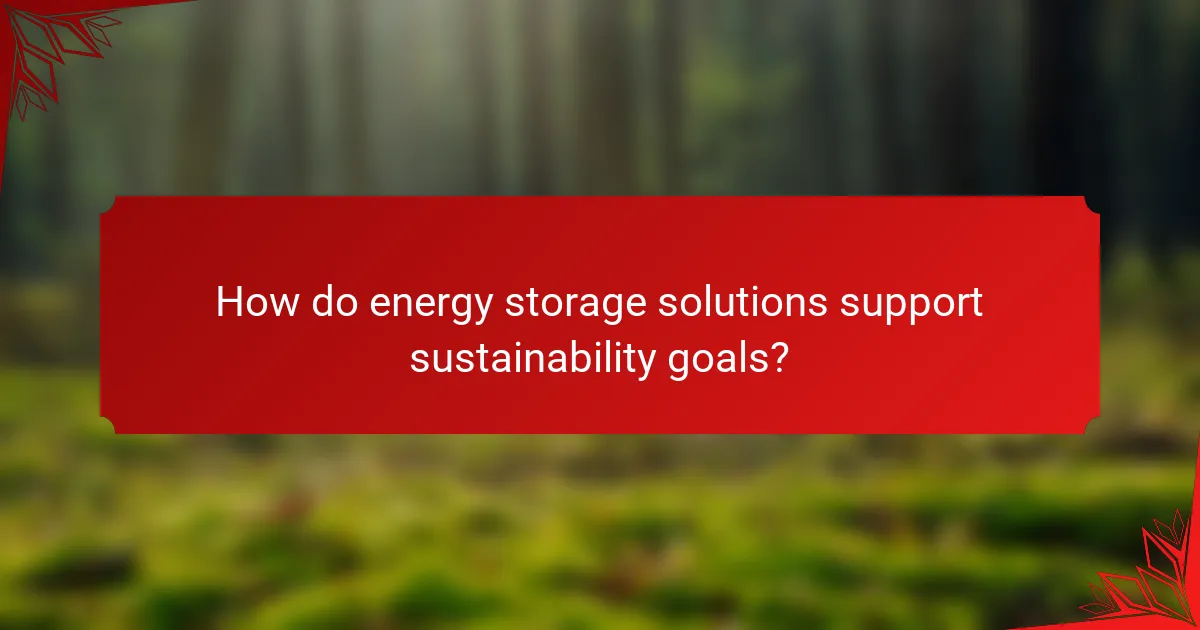
How do energy storage solutions support sustainability goals?
Energy storage solutions play a crucial role in achieving sustainability goals by enabling the integration of renewable energy sources, enhancing grid reliability, and reducing greenhouse gas emissions. By storing excess energy generated from renewables, these systems ensure a steady supply even during low production periods, making energy use more efficient and sustainable.
Capacity of Energy Storage Solutions
The capacity of energy storage solutions refers to the amount of energy they can store and deliver when needed. This capacity varies widely among different technologies, such as lithium-ion batteries, pumped hydro storage, and flywheels. For instance, lithium-ion batteries typically offer capacities ranging from a few kilowatt-hours (kWh) to several megawatt-hours (MWh), making them suitable for both residential and commercial applications.
When selecting an energy storage system, consider the specific energy needs of your application. For residential use, systems with capacities between 5 kWh and 15 kWh are common, while larger facilities may require systems that can store hundreds of MWh. Understanding your energy consumption patterns can help determine the optimal capacity for your needs.
Reliability of Energy Storage Solutions
Reliability in energy storage solutions is essential for maintaining a consistent power supply. This reliability is influenced by factors such as the technology used, the system’s design, and maintenance practices. For example, lithium-ion batteries generally have a high cycle life, allowing for thousands of charge and discharge cycles, which contributes to their reliability.
To enhance reliability, it is important to choose systems that comply with industry standards and have proven performance records. Regular maintenance and monitoring can also prevent unexpected failures and ensure that the energy storage system operates efficiently over its lifespan.
Cost-Effectiveness of Energy Storage Solutions
Cost-effectiveness is a critical consideration when evaluating energy storage solutions. The initial investment can vary significantly based on the technology and capacity, with lithium-ion batteries often being more expensive upfront compared to other options like lead-acid batteries or pumped hydro systems. However, the long-term savings from reduced energy bills and increased efficiency can offset these costs.
To assess cost-effectiveness, consider the total cost of ownership, which includes installation, maintenance, and operational costs over the system’s lifespan. Additionally, look for incentives or rebates available in your region, as these can significantly reduce the overall investment. A thorough cost-benefit analysis will help determine the best option for your specific situation.


